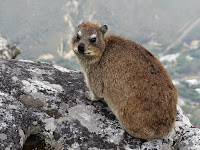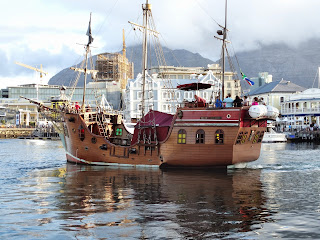Maybe we did not book smart but the flight
from Toronto to Cape Town, via London Heathrow, took a long time. We had too much
time with the layover time at Heathrow. Not enough to explore London. We just
vegetated at the airport. We left Toronto at 10 PM on a Friday and arrived in
Cape Town at 7 AM on Sunday. Both flights were solidly booked, no room to
spread out.
My first impression of Cape Town? Great !
A limo service driver helped us find an
inexpensive way to get to our pre-booked hotel. He helped even though he did
not get our fare. He was a nice guy smiled easily and did not ask for a tip.
We took the red Sportline Shuttle service
for 270 Rand for both of us from the airport to “The Three Cities Inn” directly
on the Green Market Square. The location of the hotel is ideal. I had the hotel
pre booked and the online rate was $ US 64/night without breakfast. Checking in
at the front desk would have been double the price. It really paid off to book
on line. The hotel is an older hotel but refurbished in 2011 and has all the amenities
one needs. For breakfast we went a few steps outside the hotel and prices were
reasonable. Breakfast can be had for 50 Rand ($US 5.-). Dinners are between 150
to 200 Rand per portion, which is on the high side. Carol and I were very happy with the location,
the service and the room itself. I would recommend this hotel to anybody visiting
Cape Town.
 |
| Three Cities Inn on Green Market Square |
To get an overview of the whole of Cape
Town we booked a trip on the Hop on/Hop off bus that circles the city. The main
office and stop was just behind the hotel on famous Long Street. It was very
easy to use and well organized by the bus company. We took the red tour the first day and the yellow and blue line the next day.
All are good routes. The red route gives
you the whole of the city, the yellow tour the inner city and the blue tour the
suburban surroundings. Carol was impressed with the yellow tour. I enjoyed the blue
tour. Yet to stop at the most interesting places and to combine the Table
Mountain cable car and the Waterfront, the red line is the right tour.
 |
| Table Mountain |
 |
| View of Cape Town from the Top of Table Mountain |

 |
| Fat, Tailless Squirrels |
You can walk the huge area on top of the mountain
range. The park service has installed walkways and they sure come in handy. The
terrain is very rough and littered with ancient boulders. Some estimates describe
these mountains as about 500 million years old. Compare that to the Alps in
Europe which are “only” 35 million years old. South Africa, especially Cape
Town, has been around for eons.
The San and/or the Khoi were the tribes the
Dutch and the Portuguese met when they settled here around the years 1500 to 1600.
One of the first to land in Cape Town was Portuguese Bartolomeu Dias in
1486. Vasco da Gama named the “Cape of Good Hope” (because of the great
optimism engendered by the opening of a sea route to India and the East) in the
year 1497.
The first permanent settlement in Cape Town
was on April 6, 1652 by the Dutchman Jan van Riebeck. He set up a fort for the
Dutch East India Trading Company and soon every European ship going to India or
Asia used this harbor as a supply stop over. Trade was active, including slavery.
Not much is known about the indigenous
people since no written records existed before the Europeans arrived. The San
were the original hunters and gatherers and some are still living their old
live style in the more rural areas in South Africa. San is still spoken today
and is one of the many languages one can hear.
The San were mostly replaced by the
Khoikhoi (Khoi). The Dutch named the Khoi people Hottentots, a derogatory term,
stemming from the sound of the Khoi language to Dutch ears. The Khoi, migrating in groups from Botswana centuries
ago and replacing the San people, are herdsmen. The large pastured fields (Veld)
were ideal for such endeavors. While the Europeans used this land for
agriculture and husbandry, the Khoi were exclusively herdsmen. The Khoi
followed a migratory route depending on the seasons to let their animals graze.
With the Europeans dividing up and “owning and buying“ land; and defending
those acquisitions, warfare ensued and
ultimately the Khoi were pushed into servitude.
African warfare, the Bantu attacking the
Khoi for their animals and food, only made things worse. The Bantu are multi
heritage people from the Niger/Congo area and West Sub-Saharan areas of Africa.
There are over 650 different Bantu languages. While they have some words in
common, they are distinct languages.
Africa is complicated. Migration is and
always has been part of Africa. The European immigration to Africa was just
part of the picture. Before the Europeans arrived, Africa was changing and
adapting all the time within the African continent. Europe just added their own
flavor to the mixed soup we call Africa today.
Different ideas, different life style,
different cultures and heritage still resonate throughout Africa today, CapeTown is a perfect example of the modern African way of life. Sure mistakes were
made, sure mistakes will be made, yet South Africa seems to be on the right
track to at least deal with the complicated viewpoints of all the cultures. It
is not easy. An example is the tax system here in South Africa. While every
person with an official job must pay taxes and the taxes are withheld from each
paycheck, only about 7 million people pay regular taxes out of an estimated population
of 55 million people living in South Africa. I say estimated population because
with the constant influx of migratory people from all other countries in Africa,
the population swells and dwindles like the tides. There is a constant coming
and going back.
 |
| Shanty Town in the Suburbs of Cape Town |
South Africa is aware of all of this and is
dealing with the situation the best way they know how. After apartheid ended in
1994 (it was a gradual process but officially ended with the National election
in 1994 when all races were allowed to vote), life began to improve for each
citizen of this country. While the U.S. deals in a largely Latin American
influx of immigrants (legal and illegal) South Africa has many more immigrants from
anyplace in all of Africa.
While the problems seem insurmountable; South
Africa deals with them one at a time. Instead of buying efficient street cleaning
machines, the town hires people with a broom to clean the gutters. For touristy
areas, security forces are employed that keep the citizens and tourists safe. Instead of having people beg, stalls can be
set up in certain areas with certain rules so people can hock their wares. The
city tries to let the people have their dignity. Yes, there is poverty but what
would you do if literally millions needed help at once? Cape Town is doing a
great job in helping Africa. All of us could help if, instead of buying Made in
China, we would buy Made in Africa.
One can see all these issues on a visit to
Cape Town with open eyes.While I played the tourist, riding the red line on the
double Decker hop on/off bus, I see things.
 |
| A Gated Community |
Cape Town is a modern city. It is full of
cars, traffic, public transport and multi cultural people of all colors and ethnic
backgrounds. There are tons of restaurants, bars and parks. Any kind of entertainment
is available. Come see for yourself. Cape Town was voted to be the city to see
for 2014. Carol and I listened to them and we are glad we did. GREAT town!


No comments:
Post a Comment